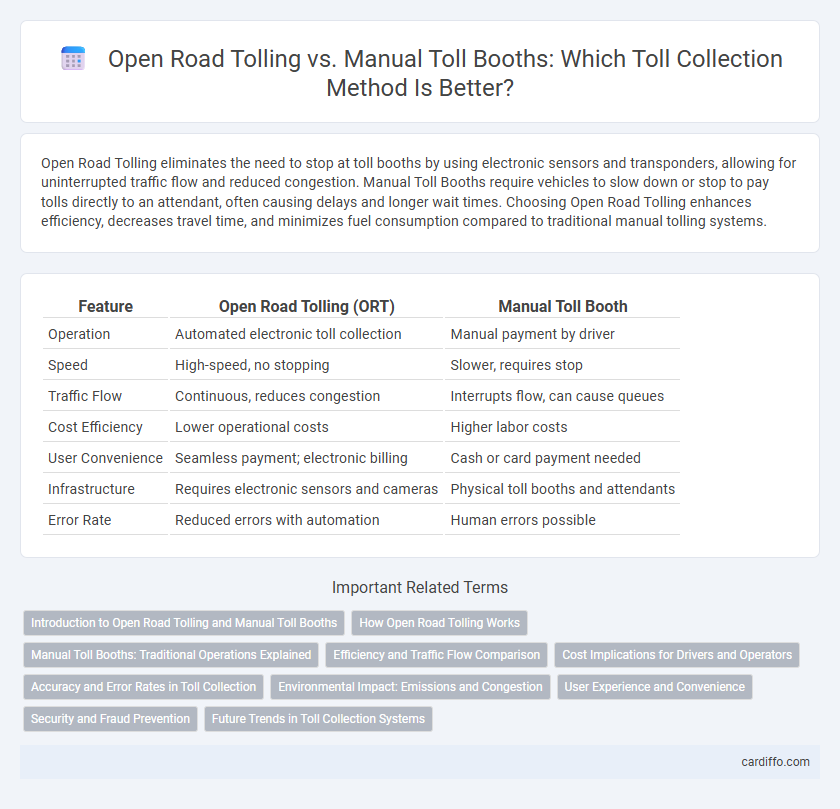Open Road Tolling eliminates the need to stop at toll booths by using electronic sensors and transponders, allowing for uninterrupted traffic flow and reduced congestion. Manual Toll Booths require vehicles to slow down or stop to pay tolls directly to an attendant, often causing delays and longer wait times. Choosing Open Road Tolling enhances efficiency, decreases travel time, and minimizes fuel consumption compared to traditional manual tolling systems.
Table of Comparison
| Feature | Open Road Tolling (ORT) | Manual Toll Booth |
|---|---|---|
| Operation | Automated electronic toll collection | Manual payment by driver |
| Speed | High-speed, no stopping | Slower, requires stop |
| Traffic Flow | Continuous, reduces congestion | Interrupts flow, can cause queues |
| Cost Efficiency | Lower operational costs | Higher labor costs |
| User Convenience | Seamless payment; electronic billing | Cash or card payment needed |
| Infrastructure | Requires electronic sensors and cameras | Physical toll booths and attendants |
| Error Rate | Reduced errors with automation | Human errors possible |
Introduction to Open Road Tolling and Manual Toll Booths
Open Road Tolling (ORT) is an electronic system that allows vehicles to pay tolls without stopping, using sensors and transponders to detect and charge vehicles at highway speeds. Manual Toll Booths require drivers to stop and pay toll attendants or use cash machines, causing potential delays and traffic congestion. ORT enhances traffic flow efficiency and reduces operational costs compared to traditional manual toll collection methods.
How Open Road Tolling Works
Open Road Tolling (ORT) operates through electronic systems that automatically detect and charge vehicles using transponders or license plate recognition as they pass under toll gantries at highway speeds, eliminating the need for stopping. This technology uses RFID sensors, cameras, and GPS to accurately capture toll data, enabling seamless traffic flow and reducing congestion compared to manual toll booths. ORT systems integrate with centralized billing platforms, providing efficient, contactless payment processing and enhanced traffic management.
Manual Toll Booths: Traditional Operations Explained
Manual toll booths require drivers to stop and pay toll collectors either with cash or cards, leading to slower traffic flow and increased congestion during peak hours. Operators handle transactions directly, verify payment, and provide change, which introduces human error and operational costs. Despite their traditional use, manual booths often result in longer wait times compared to modern electronic toll collection systems like Open Road Tolling.
Efficiency and Traffic Flow Comparison
Open Road Tolling (ORT) significantly enhances traffic flow by eliminating the need for vehicles to stop, reducing congestion and wait times compared to manual toll booths where drivers must pause to pay. ORT systems use electronic transponders and automatic license plate recognition, enabling continuous movement and increasing roadway efficiency. Manual toll booths often create bottlenecks during peak hours, whereas ORT supports smoother traffic patterns and lowers greenhouse gas emissions by minimizing idling.
Cost Implications for Drivers and Operators
Open Road Tolling reduces operational costs by eliminating the need for toll booth attendants and physical infrastructure maintenance, resulting in lower toll fees for drivers over time. Manual Toll Booths incur higher expenses due to labor costs and frequent infrastructure repairs, which are often passed on to drivers through increased toll rates. Operators benefit from Open Road Tolling's efficiency and scalability, improving revenue collection accuracy and minimizing transaction delays.
Accuracy and Error Rates in Toll Collection
Open Road Tolling (ORT) significantly reduces errors compared to manual toll booths by automating vehicle identification and payment processing through electronic transponders and camera systems. Manual toll booths are prone to human error, including incorrect change handling and misclassification of vehicle types, leading to higher error rates in toll collection. The accuracy of ORT systems improves revenue collection efficiency and minimizes disputes caused by incorrect toll charges.
Environmental Impact: Emissions and Congestion
Open Road Tolling (ORT) significantly reduces vehicle emissions by eliminating the need for cars to stop or slow down at toll booths, which minimizes idling time and fuel consumption. In contrast, manual toll booths cause congestion and longer wait times, leading to increased exhaust emissions and higher carbon footprints. Studies indicate that ORT can decrease traffic-related air pollution by up to 20%, contributing to cleaner air and reduced environmental impact.
User Experience and Convenience
Open Road Tolling (ORT) enhances user experience by enabling seamless, barrier-free travel, eliminating the need to stop and pay manually, which significantly reduces traffic congestion and wait times. Manual Toll Booths often cause delays, frustration, and inconsistency in payment processing, impacting overall convenience. ORT systems leverage electronic transponders and license plate recognition technology, providing a faster, more efficient, and hassle-free toll collection experience for drivers.
Security and Fraud Prevention
Open Road Tolling enhances security by utilizing advanced sensor technologies and automated payment systems that reduce human error and minimize opportunities for toll evasion or fraud. Manual Toll Booths rely on cash transactions and human oversight, increasing vulnerability to counterfeit currency, theft, and operator errors. Implementing electronic verification and real-time data analytics in Open Road Tolling significantly improves fraud detection and prevention compared to traditional manual methods.
Future Trends in Toll Collection Systems
Open Road Tolling (ORT) is rapidly replacing manual toll booths due to its efficiency and ability to minimize traffic congestion through electronic toll collection technologies like RFID and ANPR systems. Future trends indicate integration with connected vehicle systems and real-time data analytics to optimize traffic flow and dynamic pricing models. These advancements are expected to enhance road user convenience, reduce operational costs, and support smart city infrastructure development.
Open Road Tolling vs Manual Toll Booth Infographic

 cardiffo.com
cardiffo.com